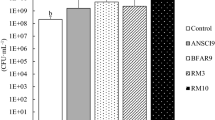Abstract
Brachionus calyciflorus (Pallas) is a common brachionid in sewage oxidation ponds. The uptake and assimilation of E. coli was optimal at concentrations of 2.7–6.9 × 108 cells ml−1 while assimilation coefficient per body weight of B. calyciflorus was found to be 10% · Ind.−1 d−1. More than two eggs per individual were produced during 24 hours when brachionids were fed with a mixutre of E. coli (109 cells · ml−1) and Chlorella spp. (106 cells · ml−1). The nutritional value of the mixture of E. coli and Chlorella spp. was found to be higher than that of bacteria alone.
Similar content being viewed by others
References
Bottrell, H. H., A. Duncan, Z. M. Gliwicz, E. Grygierek, A. Herzig, A. Hillbricht-Ilkowska, H. Kurasawa, P. Larrson & T. A. Weglenska, 1976. A review of some problems in zooplankton production studies. Norw. J. Zool. 24: 419–456.
Dumont, H., 1977. Biotic factors in the population dynamics of rotifers. Arch. Hydrobiol., Beih. 8: 98–122.
Erman, L. A., 1962a. On the qualitative aspects of feeding and selectivity of food in the plankton rotifer Brachionus calyciflorus Pall. (in Russian). Zool. Zh. 41: 34–48.
Erman, L. A., 1962b. Feeding and reproduction of the plankton rotifer Brachionus calyciflorus Pall. in mass culture (in Russian). C.r. Acad. Sci., USSR 144: 926–930.
Gilbert, J. J., 1963. Mictic female production in the rotifer Brachionus calyciflorus. J. exp. Zool. 153: 113–124.
Gilbert, J. J., 1977. Mictic female production in monogonont rotifers. Arch. Hyrobiol., Beih. 8: 142–155.
Gophen, M., 1979. Grazing of Pseudomonas aeruginosa by larvae of Culex pipiens. Aquat. Insects 1: 245–249.
Gophen, M., 1977. Feeding of Daphnia on Chlamydomonas and Chlorobium. Nature 265: 271–272.
Hadas, O., 1982. Elimination, ingestion and digestion of bacteria by the zooplankton Daphnia magna. Ph.D. Thesis, Hebrew Univ., Jerusalem, 109 pp.
Hadas, O., B. Z. Cavari, Y. Kott & U. Bachrach, 1982. Preferential feeding behaviour of Daphnia magna. Hydrobiologia 89: 49–52.
Hadas, O. & B. Z. Cavari, 1983a. Assimilation of E. coli cells by Daphnia magna on the whole organism level. Hydrobiologia 102: 163–171.
Hadas, O., Y. Kott, U. Bachrach & B. Z. Cavari, 1983b. Ability of Daphnia cell-free extract to damage Escherichia coli cells. Appl. envir. Microbiol. 45: 1242–1246.
Halbach, U. & G. Halbach-Keup, 1974. Quantitative Beziehungen zwischen Phytoplankton und der Populationsdynamik des Rotators Brachionus calyciflorus Pallas. Befunde aus Laboratoriumseksperimenten und Freilanduntersuchungen. Arch. Hydrobiol. 73: 273–309.
Hutchinson, G. E., 1967. A treatise on limnology. II: Introduction to lake biology and the limnoplankton. J. Wiley & Sons. NY, 1115 pp.
O'Brien, J. & F. DeNoyelles, 1972. Photosynthetically elevated pH as a factor in zooplankton mortality in nutrient enriched ponds. Ecology 53: 605–614.
Pourriot, R., 1965. Recherches sur l'ecologie des rotiferes. Vie Milieu, Suppl. 21, 224 pp.
Pourriot, R., 1977. Food and feeding habits of rotifers. Arch. Hydrobiol., Beih. 8: 243–260.
Starkweather, P. L., 1980. Behavioral determinants of diet quantity and diet quality in Brachionus calyciflorus. In W. C. Kerfoot (ed.), Evolution and ecology of zooplankton communities. University Press, Hannover (NH); Lond. 151–157.
Starkweather, P. L. & J. J. Gilbert, 1977a. Feeding in the rotifer Brachionus calyciflorus. II. Effect of food density on feeding rates using Euglena gracilis and Rhodotorula glutinis. Oecologia 28: 133–139.
Starkweather, P. L. & J. J. Gilbert, 1977b. Radiotracer determination of feeding in Brachionus calyciflorus: The importance of gut-passage times. Arch. Hydrobiol., Beih. 261–263.
Starkweather, P. L., J. J. Gilbert & T. M. Frost, 1979. Bacterial feeding by the rotifer Brachionus calyciflorus: Clearance and ingestion rates, behaviour and population dynamics. Oecologia 44: 26–30.
Voigt, M., 1957. Rotatoria: Die Rädertiere mitteleuropas. Gebrüder Borntraeger, Berlin-Nikolassee, 508 pp.
Wynne, D. & M. Gophen, 1981. Phosphatase activity in freshwater zooplankton. Oikos 37: 369–376.
Author information
Authors and Affiliations
Rights and permissions
About this article
Cite this article
Seaman, M.T., Gophen, M., Cavari, B.Z. et al. Brachionus calyciflorus Pallas as agent for the removal of E. coli in sewage ponds. Hydrobiologia 135, 55–60 (1986). https://doi.org/10.1007/BF00006458
Issue Date:
DOI: https://doi.org/10.1007/BF00006458




